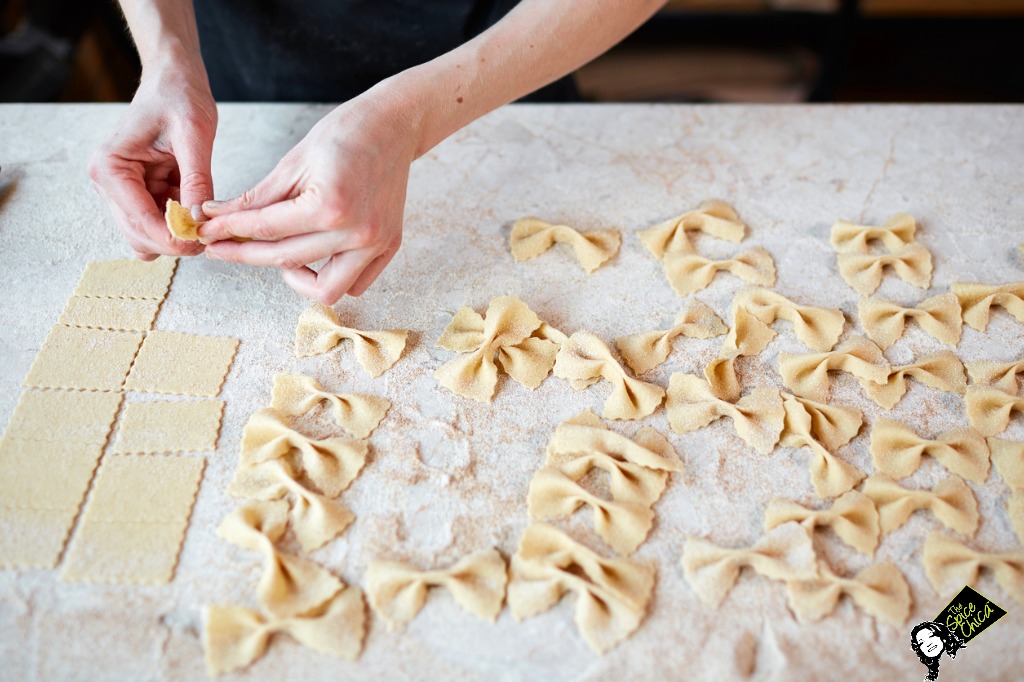Farfalle (Italian: [farˈfalle]) are a type of pasta commonly known as bow-tie pasta. The name is derived from the Italian word farfalla(butterfly). The ‘e’ at the end of the word is the Italian feminine plural ending, making the meaning of the word “butterflies”. In the Italian city of Modena, farfalle are known as strichetti. A larger variation of farfalle is known as farfalloni, while the miniature version is called farfalline. Farfalle date back to the 16th century in the Lombardy and Emilia-Romagna regions of Northern Italy.
Serves 4
- 2large eggs
- 2/3cup all-purpose flour
- 2/3cup semolina flour
- Mix the all-purpose flour and semolina flour together, then make a volcano-like mound of flour on your work surface. Crack the eggs into the hollow and sprinkle with salt. Then, using a fork, gently stir the eggs, incorporating the flour from the walls of the volcano little by little. Once the dough has become workable by hand — a fair amount of flour will have been worked in — use your hands to incorporate the rest of the loose flour. When the dough has come together smoothly, knead the ball for about 5 minutes. If it’s feeling moist, incorporate some more flour into the dough. You want to end up with a ball that’s not sticky, but still soft. Cover the ball of dough and let it relax for about 30 minutes.
- Cut the dough into four pieces. Keeping the unworked dough covered, take a piece and begin rolling it out with a rolling pin, keeping its shape roughly rectangular. You want it to end up thin, about 1 millimeter in width. Using a sharp knife, slice the pasta into pieces that are about 1 1/2 x 1 inch. Along the long side, pinch each rectangle in the middle very hard. Congrats, you just made pasta! Place the farfalle on a baking sheet liberally dusted with flour and keep it covered. Continue in the same fashion with the rest of the dough. If you want to dry out the pasta, simply leave it out overnight covered with a dish towel.
- The fresh pasta should cook up in about 2 to 3 minutes. The dried pasta will take about the same amount of time as the stuff you get at the grocery store.
—————————————————————————————————-
Farfalle come in several sizes, but they all have a distinctive “bow tie” shape. Usually, the farfalle are formed from a rectangle or oval of pasta, with two of the sides trimmed to a ruffled edge and the center pinched together to make the unusual shape of the pasta. A ridged version of the pasta is known as farfalle rigate. Though usable with most sauces, farfalle are best suited to cream and tomato sauces.[citation needed]
In addition to plain and whole-wheat varieties, colours are added by mixing certain ingredients into the dough, which also affects the flavor (as with any pasta). For example, beetroot can be used for red, spinach for green and cuttlefish ink for black.. A tomato variety may also be available. Green, white, and red varieties are often sold together in a mix that recalls the colors of the flag of Italy.
References: WIKIPEDIA AND "Farfalle Recipes". Farfalle Recipe Book. Archived from the original on 2012-03-14. Retrieved 2011-05-21.


